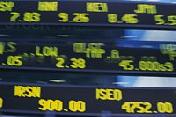
 |
|
| Financial Terms | |
| Stockholder equity |
|
Information about financial, finance, business, accounting, payroll, inventory, investment, money, inventory control, stock trading, financial advisor, tax advisor, credit.
Main Page: accounting, stock trading, finance, inventory control, credit, financial advisor, payroll, financial, |
Definition of Stockholder equity
Stockholder equityBalance sheet item that includes the book value of ownership in the corporation. It
Related Terms:Stockholder's equityThe residual claims that stockholders have against a firm's assets, calculated by RATE OF RETURN ON STOCKHOLDERS’ EQUITYThe percentage return or profit that management made on each dollar stockholders invested in a company. Here’s how you figure it: RATIO OF DEBT TO STOCKHOLDERS’ EQUITYA ratio that shows which group—creditors or stockholders—has the biggest stake in or the most control of a company: STOCKHOLDERS’ (OR OWNERS’) EQUITYThe value of the owners’ interests in a company. Stockholders' equityThe total amount of contributed capital and retained earnings; synonymous with shareholders’ equity. stockholders' equity, statement of changes inAlthough often considered Asset/equity ratioThe ratio of total assets to stockholder equity.  Book value per shareThe ratio of stockholder equity to the average number of common shares. Book value Debt/equity ratioIndicator of financial leverage. Compares assets provided by creditors to assets provided Long-term debt/capitalizationIndicator of financial leverage. Shows long-term debt as a proportion of the Price/book ratioCompares a stock's market value to the value of total assets less total liabilities (book Return on equity (ROE)Indicator of profitability. Determined by dividing net income for the past 12 All equity rateThe discount rate that reflects only the business risks of a project and abstracts from the Bottom-up equity management styleA management style that de-emphasizes the significance of economic Common stock/other equityValue of outstanding common shares at par, plus accumulated retained Conflict between bondholders and stockholdersThese two groups may have interests in a corporation that  Deferred equityA common term for convertible bonds because of their equity component and the Dual syndicate equity offeringAn international equity placement where the offering is split into two EquityRepresents ownership interest in a firm. Also the residual dollar value of a futures trading account, Equity capAn agreement in which one party, for an upfront premium, agrees to compensate the other at Equity claimAlso called a residual claim, a claim to a share of earnings after debt obligation have been Equity collarThe simultaneous purchase of an equity floor and sale of an equity cap. Equity contribution agreementAn agreement to contribute equity to a project under certain specified Equity floorAn agreement in which one party agrees to pay the other at specific time periods if a specific Equity kickerUsed to refer to warrants because they are usually issued attached to privately placed bonds. Equity marketRelated:Stock market Equity multiplierTotal assets divided by total common stockholders' equity; the amount of total assets per Equity optionsSecurities that give the holder the right to buy or sell a specified number of shares of stock, at Equity swapA swap in which the cash flows that are exchanged are based on the total return on some stock Equity-linked policiesRelated: Variable life EquityholdersThose holding shares of the firm's equity. Euroequity issuesSecurities sold in the Euromarket. That is, securities initially sold to investors Foreign equity marketThat portion of the domestic equity market that represents issues floated by foreign companies. GEMs (growing-equity mortgages)Mortgages in which annual increases in monthly payments are used to Investor's equityThe balance of a margin account. Related: buying on margin, initial margin requirement. Leveraged equityStock in a firm that relies on financial leverage. Holders of leveraged equity face the Long-term debt to equity ratioA capitalization ratio comparing long-term debt to shareholders' equity. Preferred equity redemption stock (PERC)Preferred stock that converts automatically into equity at a Shareholders' equityThis is a company's total assets minus total liabilities. A company's net worth is the StockholderHolder of equity shares in a firm. Stockholder's booksSet of books kept by firm management for its annual report that follows Financial Stratified equity indexingA method of constructing a replicating portfolio in which the stocks in the index Top-down equity management styleA management style that begins with an assessment of the overall Total debt to equity ratioA capitalization ratio comparing current liabilities plus long-term debt to EquityFunds raised from shareholders. Contra-equity accountAn account that reduces an equity account. An example is Treasury stock. EquityAmounts contributed to the company by the owners (contributed capital) plus the residual earnings of the business (retained earnings). Shareholders' equityThe total amount of contributed capital and retained earnings; synonymous with stockholders' equity. debt-to-equity ratioA widely used financial statement ratio to assess the equityRefers to one of the two basic sources of capital for a business, the owners' equityRefers to the capital invested in a business by its shareowners return on equity (ROE)This key ratio, expressed as a percent, equals net Cost of EquitySame as the cost of common stock. Sometimes viewed as the Return on Common Equity RatioA measure of the percentage return earned on the value of the EquityThe difference between the total of all recorded assets and liabilities on the balance Owners' equityThe total of all capital contributions and retained earnings on a business’s StockholderA person or entity that owns shares in a corporation. EquityOwnership. Common stock represents equity in a corporation. Equity MethodAccounting method for an equity security in cases where the investor has sufficient Equity SecurityAn ownership interest in an enterprise, including preferred and common stock. Shareholders' EquityThe residual interest or owners' claims on the assets of a corporation Debt/Equity RatioA comparison of debt to equity in a company's capital structure. EquityThe net worth of a business, consisting of capital stock, capital (or paid-in) surplus (or retained earnings), and, occasionally, certain net worth reserves. Common equity is that part of the total net worth belonging to the common shareholders. Total equity includes preferred shareholders. The terms common stock, net worth, and common equity are frequently used interchangeably. Equity Buy-BackRefers to the investors percentage ownership of a company that can be re-acquired by the company, usually at a pre-determined amount. Quasi-EquityFunds, other than paid-up capital and retained earnings, employed in a business and which will remain in a business as permanent capital. Shareholder's EquityRepresents the total assets of a corporation less liabilities. equityThe net worth of a company. This represents the ownership interest of the shareholders (common and preferred) of a company. For this reason, shares or stocks are often known as equities. Equity-based insuranceLife insurance or annuity product in which the cash value and benefit level fluctuate according to the performance of an equity portfolio. Equity investmentThrough equity investment, investors gain part ownership of the corporation. The primary type of equity investment is corporate stock. Balance sheet identityTotal Assets = Total Liabilities + Total stockholders' equity Capital structureThe makeup of the liabilities and stockholders' equity side of the balance sheet, especially Common stock ratiosRatios that are designed to measure the relative claims of stockholders to earnings Financial riskThe risk that the cash flow of an issuer will not be adequate to meet its financial obligations. Financing decisionsDecisions concerning the liabilities and stockholders' equity side of the firm's balance Net worthCommon stockholders' equity which consists of common stock, surplus, and retained earnings. Reverse stock splitA proportionate decrease in the number of shares, but not the value of shares of stock BALANCE SHEETA “snapshot” statement that freezes a company on a particular day, like the last day of the year, and shows the balances in its asset, liability, and stockholders’ equity accounts. It’s governed by the formula: BOOK VALUE OF COMMON STOCKThe theoretical amount per share that each stockholder would receive if a company’s assets were sold on the balance sheet’s date. Book value equals: CASH FLOWS FROM OPERATIONSA section on the cash-flow stockholders’ equity statement that shows how much cash came into a company and how much went out during the normal course of business. financial accountinga discipline in which historical, monetary net worthBook value of common stockholders’ equity plus preferred stock. Cash Flow Provided or Used from Financing ActivitiesCash receipts and payments involving Related to : financial, finance, business, accounting, payroll, inventory, investment, money, inventory control, stock trading, financial advisor, tax advisor, credit. |